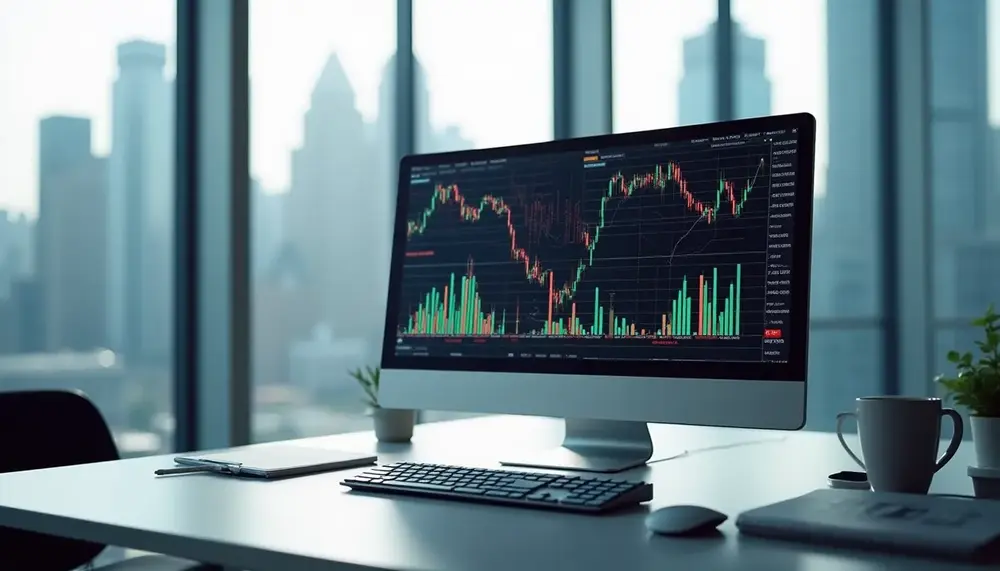Table of Contents:
Key Distinctions Between Trading and Financial Markets
Key Distinctions Between Trading and Financial Markets
At first glance, the terms "trading" and "financial markets" might seem interchangeable, but a closer look reveals essential differences that shape how participants interact with the world of finance. Trading refers specifically to the act of buying and selling financial instruments—think stocks, options, or futures—with the goal of capitalizing on price fluctuations. It’s a dynamic, often fast-paced activity that demands quick decision-making and an appetite for risk.
In contrast, financial markets are the vast, structured environments where this trading occurs. These markets include not only stock exchanges but also bond markets, derivatives platforms, and even decentralized venues for cryptocurrencies. Financial markets provide the infrastructure, rules, and mechanisms—such as order books, clearinghouses, and regulatory oversight—that make trading possible and, ideally, fair and transparent.
Another crucial distinction lies in scope and function. Trading is an individual or institutional activity, shaped by personal strategies, time horizons, and risk tolerance. Financial markets, however, serve a broader purpose: they facilitate capital formation, enable price discovery, and help allocate resources efficiently across the economy. Without the market, trading would be like playing chess without a board—there’d be nowhere to move the pieces.
Understanding these distinctions is not just academic. For anyone aiming to participate effectively, recognizing the boundaries and interplay between trading as an action and financial markets as the arena is fundamental. This awareness informs everything from regulatory compliance to the selection of trading strategies and tools.
Essential Elements of Trading in Modern Financial Markets
Essential Elements of Trading in Modern Financial Markets
Modern trading is a sophisticated interplay of technology, regulation, and human psychology. To navigate this landscape, you need to understand several core components that define today’s trading environment—beyond just the act of buying and selling.
- Electronic Trading Platforms: Nearly all trading now happens via digital interfaces. These platforms provide real-time data, order execution, and analytical tools, fundamentally altering speed and accessibility for traders worldwide.
- Algorithmic and High-Frequency Trading: Algorithms, sometimes executing thousands of trades per second, dominate many markets. They rely on mathematical models and vast data streams, creating both liquidity and new risks, such as flash crashes.
- Market Microstructure: The way orders are matched, routed, and filled—down to the millisecond—can influence price formation and trading outcomes. Concepts like order types, tick sizes, and latency are critical for those seeking an edge.
- Regulatory Oversight: Modern markets are tightly regulated to prevent manipulation, insider trading, and systemic risk. Compliance with rules from authorities like the SEC or ESMA is not optional; it’s a prerequisite for participation.
- Risk Management Systems: Advanced tools now allow traders to set stop-losses, monitor exposure, and automate responses to adverse moves. Effective risk controls are essential for long-term survival in volatile markets.
- Access to Global Markets: With the click of a button, traders can participate in markets across continents, from equities in Tokyo to commodities in Chicago. This global reach brings both opportunity and complexity, especially regarding time zones and market-specific rules.
Mastering these elements isn’t just about technical know-how—it’s about integrating them into a coherent approach that matches your goals and risk appetite. In the modern era, successful trading demands both adaptability and a deep understanding of the evolving market ecosystem.
Entry Requirements and Capital Needs: Navigating Market Access
Entry Requirements and Capital Needs: Navigating Market Access
Gaining access to modern financial markets isn’t as simple as opening an app and diving in. There are specific entry requirements and capital thresholds that shape who can participate and how. These requirements differ depending on the asset class, jurisdiction, and the nature of the trading activity.
- Account Verification: Regulatory standards require identity and residency verification. This means providing official documents and sometimes proof of income or employment before you can execute your first trade.
- Minimum Deposit Levels: Many brokers set minimum deposit amounts, which can range from a few hundred to several thousand dollars. Higher-risk products like futures or margin accounts often demand even larger initial funding.
- Margin and Leverage Rules: Accessing leveraged products means meeting stricter capital requirements. For example, day traders in the U.S. typically need to maintain at least $25,000 in their account to comply with pattern day trading rules.
- Product-Specific Qualifications: Some instruments, such as options or certain derivatives, require passing knowledge assessments or demonstrating trading experience before approval.
- Jurisdictional Restrictions: Not all products or markets are available everywhere. Local regulations may limit access to specific exchanges or asset types, so knowing your region’s rules is essential.
Capital needs are not just about meeting a broker’s minimums—they also determine your flexibility, risk tolerance, and the range of strategies you can pursue. Skimping on capital can mean forced liquidations or missed opportunities, while overextending can expose you to losses you can’t absorb. Careful planning and honest self-assessment are the first steps to navigating market access responsibly.
Day Trading in Financial Markets: Risks, Fees, and Real-World Outcomes
Day Trading in Financial Markets: Risks, Fees, and Real-World Outcomes
Day trading is a high-wire act that attracts those seeking rapid gains, but it’s riddled with complexities that go far beyond simple buy-and-sell tactics. The real world of day trading is defined by a trio of challenges: hidden risks, cumulative fees, and outcomes that rarely match the hype.
- Volatility Exposure: Day traders are uniquely vulnerable to sudden price swings, news shocks, and liquidity gaps. A single unexpected event can erase hours of careful work in seconds.
- Fee Accumulation: Each trade incurs transaction costs—commissions, bid-ask spreads, and sometimes platform fees. Over dozens or hundreds of trades per day, these costs add up and can quietly eat into any profits.
- Emotional Toll: The psychological strain of rapid-fire decision-making, frequent losses, and the pressure to outperform can lead to burnout or impulsive errors. Emotional discipline is often the real battleground.
- Technology Reliance: Fast execution and reliable data feeds are essential. Even a brief internet outage or software glitch can result in missed opportunities or unintended losses.
- Tax Implications: Profits from day trading are usually taxed as ordinary income, not at the lower rates for long-term investments. This can significantly reduce net returns, especially in high-frequency strategies.
- Real-World Success Rates: Most studies and broker disclosures suggest that a minority of day traders consistently make profits. The majority experience losses, often due to underestimating the combined impact of risk and fees.
In practice, day trading is not a shortcut to wealth. It demands a robust strategy, technical proficiency, and a thick skin. Those who succeed tend to treat it as a disciplined business, not a game of chance.
How Securities Prices Are Established in Financial Markets
How Securities Prices Are Established in Financial Markets
Securities prices in financial markets are not set in stone—they’re shaped by a continuous tug-of-war between buyers and sellers. This process, known as price discovery, is driven by a blend of transparent auction mechanisms, order flows, and external influences.
- Order Book Dynamics: Every market maintains an electronic order book where buy (bid) and sell (ask) orders are listed. The highest bid and lowest ask define the current price range. When a buy and sell order match, a transaction occurs, setting the latest price.
- Liquidity and Depth: The number of orders at each price level—market depth—affects how easily large trades can be executed without moving the price. Thinly traded securities are more prone to sharp price jumps.
- Market Makers: These participants provide continuous buy and sell quotes, ensuring there’s always a counterparty for trades. Their activity narrows the bid-ask spread and stabilizes prices, especially in less liquid markets.
- External Catalysts: News releases, earnings reports, and macroeconomic data can instantly shift supply and demand, leading to rapid price adjustments. Automated trading systems often react to such events within milliseconds.
- Implied Volatility: In options and derivatives markets, price is also influenced by expectations of future volatility. Higher anticipated swings typically translate into higher option premiums.
Ultimately, securities prices are the real-time result of countless individual decisions, filtered through technology and market structure. The process is dynamic, adaptive, and—at times—unpredictable, reflecting both rational analysis and human emotion.
Options Trading: Strategic Uses and Potential Pitfalls
Options Trading: Strategic Uses and Potential Pitfalls
Options trading opens a toolkit of possibilities for those seeking more than simple directional bets. By using calls and puts, traders can craft strategies that profit from volatility, hedge existing positions, or generate income—sometimes all at once. Yet, these benefits come with their own web of complexities and risks.
- Strategic Uses:
- Hedging: Investors often use options to protect portfolios against adverse moves. For example, buying puts can limit downside risk without selling the underlying asset.
- Income Generation: Selling covered calls is a popular method to earn extra yield on stocks already owned, though it caps potential upside.
- Volatility Plays: Straddles and strangles allow traders to benefit from sharp price movements in either direction, making them useful around earnings or major news events.
- Leveraged Exposure: Options provide a way to control large positions with less capital, amplifying both potential gains and losses.
- Potential Pitfalls:
- Complex Pricing: Option values depend on multiple factors—time decay, implied volatility, and underlying price. Misjudging these can lead to unexpected losses, even if the market moves in your favor.
- Liquidity Risks: Some contracts trade infrequently, resulting in wide bid-ask spreads and difficulty exiting positions at fair prices.
- Assignment Risk: Sellers of options may be assigned unexpectedly, forcing them to buy or sell the underlying asset, sometimes at inopportune moments.
- Overleveraging: The leverage inherent in options can tempt traders to take outsized risks, magnifying losses beyond initial expectations.
- Regulatory and Tax Complexity: Options are subject to unique reporting rules and tax treatments, which can complicate compliance and affect net returns.
Mastery of options trading demands not just technical skill, but also a keen awareness of these strategic uses and lurking pitfalls. Without a clear plan and robust risk controls, even sophisticated strategies can unravel quickly.
Understanding Critical Trading Terms in Financial Markets
Understanding Critical Trading Terms in Financial Markets
To operate confidently in financial markets, you need to grasp certain terms that shape both analysis and execution. These concepts go beyond the basics and frequently appear in market commentary, research, and trading platforms.
- Penny Stock: Refers to shares of small companies that typically trade below $5 per share. They’re notorious for high volatility and limited liquidity, making them both tempting and risky for speculative traders.
- Cboe Volatility Index (VIX): This index measures the market’s expectation of near-term volatility, often called the “fear gauge.” A rising VIX signals growing uncertainty or anxiety among investors.
- Price Target: An analyst’s forecast of a security’s future price, usually based on fundamental or technical analysis. Price targets guide trading decisions but are not guarantees—market conditions can shift rapidly.
- Short Position: A strategy where a trader borrows and sells a security, aiming to buy it back later at a lower price. While shorting can yield profits in falling markets, losses are theoretically unlimited if prices rise instead.
- Stop-Loss Order: An automatic instruction to sell a security when it reaches a specified price, designed to limit potential losses. Stop-losses are vital for risk management, especially in volatile environments.
- Slippage: The difference between the expected price of a trade and the actual executed price. Slippage often occurs in fast-moving or illiquid markets and can impact trading performance.
- Liquidity: Describes how quickly and easily an asset can be bought or sold without affecting its price. High liquidity generally means tighter spreads and smoother trade execution.
Familiarity with these terms helps decode financial news, analyze strategies, and communicate more effectively with other market participants. They’re the building blocks for making sense of the market’s complex language.
Practical Tools and Resources to Support Trading Precision
Practical Tools and Resources to Support Trading Precision
Sharpening your trading edge requires more than instinct—it demands access to robust tools and up-to-date resources. Today’s traders leverage a suite of specialized solutions to analyze, simulate, and refine their strategies with greater accuracy.
- Trading Simulators: Platforms offering real-time or historical market data let you practice strategies without risking capital. These environments are invaluable for stress-testing new ideas and building confidence before live execution.
- Independent Research Portals: Sites that aggregate unbiased analyses, ratings, and financial product comparisons help cut through marketing noise. They enable more objective decision-making by presenting side-by-side evaluations of brokers, platforms, and asset classes.
- Customizable Charting Software: Advanced charting tools allow you to visualize trends, apply technical indicators, and set personalized alerts. Tailoring these features to your trading style can reveal subtle market signals often missed by standard platforms.
- Economic Calendar Feeds: Real-time updates on macroeconomic events, earnings releases, and geopolitical developments help you anticipate volatility and adjust positions proactively.
- Order Flow Analytics: Tools that dissect market depth, volume spikes, and order imbalances provide a granular view of supply and demand shifts—essential for timing entries and exits with precision.
- Community Forums and Peer Networks: Engaging with experienced traders in moderated forums or private groups can surface actionable insights, crowd-sourced strategies, and timely warnings about emerging risks.
Integrating these resources into your workflow can transform raw information into actionable intelligence, ultimately enhancing your ability to execute trades with discipline and clarity.
Comprehensive Insights: Building Knowledge for Informed Decision-Making
Comprehensive Insights: Building Knowledge for Informed Decision-Making
Developing true expertise in trading and financial markets hinges on continuous learning and critical self-reflection. The most successful market participants cultivate a habit of evaluating their own performance, staying alert to new developments, and adapting to changing market conditions.
- Performance Analysis: Regularly reviewing trade outcomes—both wins and losses—helps uncover patterns, biases, and areas for improvement. Tracking metrics such as risk-adjusted returns or drawdowns offers a clearer picture of strategy effectiveness.
- Market Adaptability: Markets evolve in response to technology, regulation, and global events. Staying flexible and updating your approach in light of new data or shifting trends is essential for long-term success.
- Cross-Disciplinary Learning: Insights from behavioral finance, statistics, and even psychology can sharpen your decision-making. Exploring these fields can reveal why markets move the way they do and how emotions influence choices.
- Source Evaluation: Not all information is created equal. Prioritizing data from reputable, transparent sources and verifying facts before acting reduces the risk of costly errors driven by rumors or misinformation.
- Scenario Planning: Considering multiple outcomes—rather than fixating on a single forecast—prepares you for unexpected market moves. This mindset encourages resilience and more balanced risk-taking.
By weaving these practices into your routine, you build a foundation for decisions that are not just reactive, but informed and forward-looking. The path to mastery is less about chasing certainty and more about embracing a disciplined, evidence-based approach.
Experiences and Opinions
Many users find trading platforms challenging at first. The initial learning curve can be steep. Users often report difficulty in navigating interfaces. This can lead to frustration and missed opportunities. On platforms like Gartner Peer Insights, traders share their experiences with various systems. Some praise the functionality, while others note that certain features are not user-friendly.
A common issue among traders is the emotional aspect of trading. Users frequently mention the psychological stress that comes with trading decisions. The pressure to make quick choices can lead to mistakes. For instance, some report panic selling during market drops. This highlights the need for strong emotional discipline.
Another significant concern is the cost associated with trading. Many users express frustration over hidden fees. While some platforms offer low commissions, additional costs can accumulate quickly. Reports on Forex Trading Course Reviews indicate that users often feel misled about total expenses. This can deter new traders who are unaware of the complete fee structure.
Education is crucial for success in trading. Numerous users emphasize the value of comprehensive training. Many recommend taking courses to build foundational knowledge. However, experiences vary widely. Some users claim that paid courses do not deliver the promised results. For example, one user reported losing over $15,000 due to ineffective strategies learned in a course, as highlighted in a blog by the FTC.
Community support plays a vital role in traders' experiences. Many users appreciate the shared knowledge in forums. They often discuss strategies and market trends. This collaborative environment helps new traders feel less isolated. However, it also introduces the risk of following poor advice. Users need to critically evaluate the information they receive.
Technical issues can also hinder trading performance. Users often report slow execution times during high volatility. This can lead to significant losses. Some platforms struggle to handle the volume of trades during peak times. As a result, users may miss critical market movements.
In summary, trading is filled with challenges. Users face emotional, educational, and technical hurdles. While many find the thrill of trading rewarding, others experience significant stress and financial loss. The key to success appears to be a combination of solid education, community support, and careful platform selection.
FAQ on Trading and Modern Financial Markets
What is the main difference between trading and financial markets?
Trading refers to the act of buying and selling financial instruments to profit from price movements. Financial markets are the structured environments where this trading occurs, offering the infrastructure, regulations, and mechanisms for price discovery and capital allocation.
What requirements must be met to start trading in financial markets?
To start trading, you must verify your identity, meet minimum deposit requirements set by your broker, and sometimes pass knowledge assessments for certain products. Regulations and access may vary depending on asset class and your location.
What risks are associated with day trading?
Day trading involves high exposure to market volatility, significant transaction fees, intense psychological pressure, and reliance on technology. Most day traders do not achieve consistent profits and may face rapid financial losses, especially without disciplined risk management.
How are security prices determined in financial markets?
Prices are established through order book dynamics, where bids and asks are matched. Market makers, liquidity, news events, and anticipated volatility all influence the process, resulting in prices that reflect ongoing supply and demand shifts.
Which tools and resources can improve trading outcomes?
Valuable tools include trading simulators, independent research portals, advanced charting software, economic calendars, order flow analytics, and trader communities. Integrating these resources aids in refining strategies and making more informed decisions.











